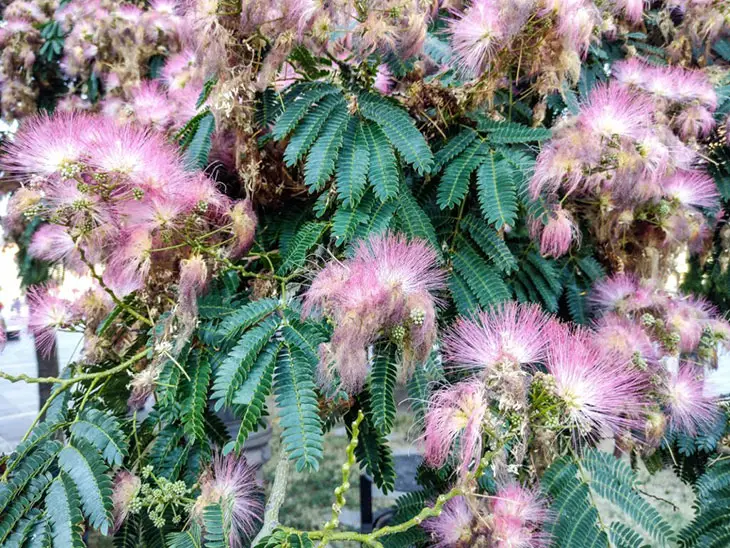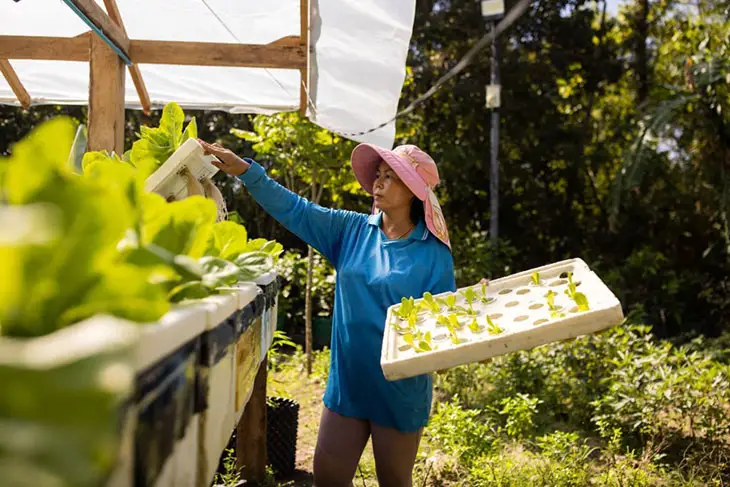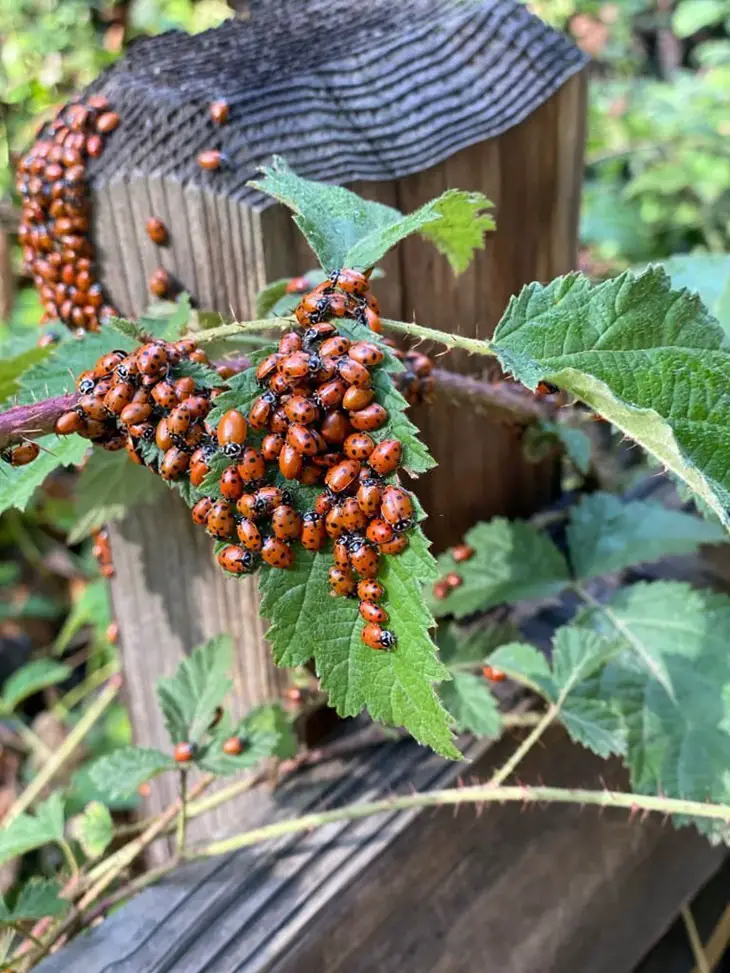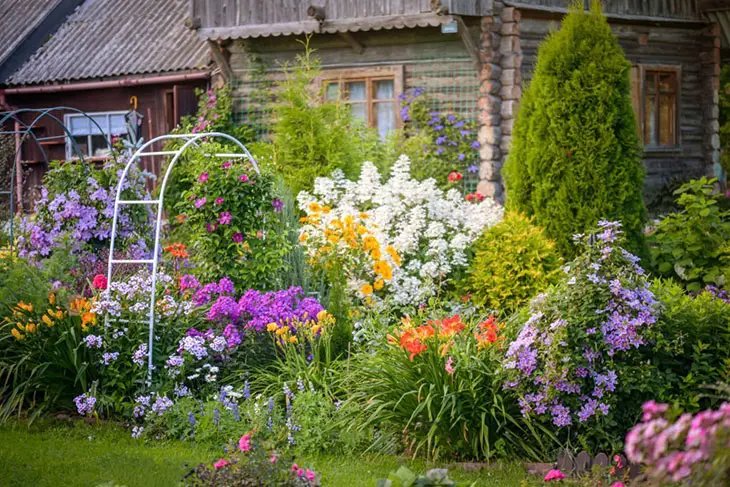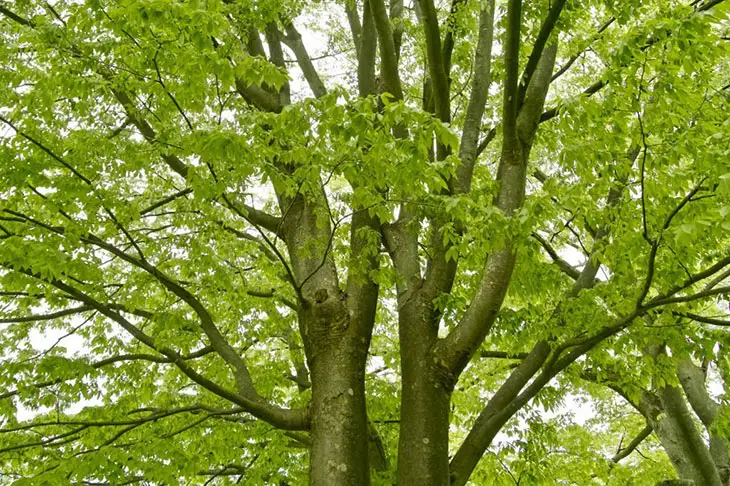
In Utah, where water can be scarce, some trees are really good at surviving. These tough trees can handle the dry weather and still grow well.
From the strong Utah juniper with its twisty branches to the colorful red maple, these trees are important for the environment.
Let’s dig in to learn about 15 drought tolerant trees Utah that can survive without much water.
15 Drought Tolerant Trees Utah
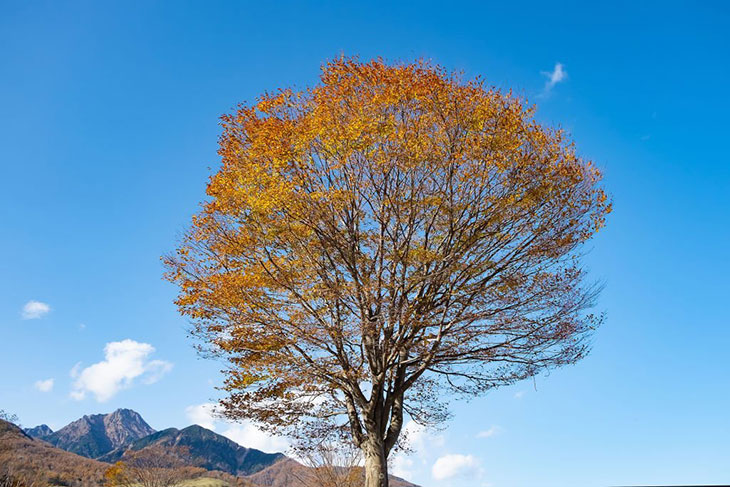
Some common drought-tolerant trees in Utah that can withstand the dry conditions and still thrive include Pinyon Pine, Utah Juniper, Red Maple, Black Walnut, and more.
They have attractive foliage and large shades, perfect for Utah landscapes.
Red Maple
Like maple trees in Ohio, red maple trees in Utah are popular for their adaptability to different soils and rapid growth.
They’re considered shade trees for Utah due to their wide canopy and ability to withstand drought.
These trees add year-round color, with green stems turning red in winter, reddish-tinged new leaves maturing to green, and deep red or yellow display in the fall.
They grow quickly and can thrive in various soil types, reaching heights of 40 to 60 feet with a spread of about 40 feet.
Red maple trees are suitable for zones 3 to 9, but it’s important to note that consuming even a small amount of their dry, wilted leaves can be toxic to horses.
Black Walnut
It’s not hard to encounter a black walnut tree in Utah. Its wood makes a worthwhile contribution to the income sources of residents and economic growth in the state.
This type of tree is special because when it’s in a group, it grows straight up and doesn’t have many branches down low.
But if it’s alone in a field, it spreads out more and grows branches lower down. It is good because it makes it easier to pick the sweet, round nuts it produces, which are about two to three inches big.
The nuts taste good and are healthy, so people usually use them to make soups, baking, and other dishes. The hard shells of the nuts kept them safe during the winter.
Hybrid Poplar
Hybrid Poplar trees, or Populus Deltoides x Populus nigra, are found in various places in Utah. When fully grown, they reach about 40 to 50 feet tall, and their branches can spread up to 30 feet wide.
These trees grow really fast, adding about 8 feet to their height every year. They’re great for making shade quickly and are often used to block views or create privacy.
But there’s a catch with their rapid growth – their branches can easily break.
Thus, it’s not a good idea to plant these trees where the branches could hang over your house or other things that might get damaged.
Japanese Zelkova
The Japanese Zelkova (Zelkova serrata) is a smart alternative to elm trees, resembling them without the risk of Dutch elm disease.
It’s an optimal choice for city landscapes, offering shade for homes and streets.
With its unique spreading shape and peeling bark, it adds a charming beauty to urban areas.
You can’t take your eyes off their small green and beautiful flowers in late spring and the makeover from medium green leaves into striking yellow, red, and purple tones in autumn.
Growing 50 to 80 feet tall and spreading 50 to 75 feet, it’s one of the good shade trees for Utah.
Japanese Zelkova is also popular for its drought-tolerant features, suiting Utah’s dry climate well, so they’re planted in many routes.
Joshua Tree
The Joshua tree, the biggest yucca family member, is a recognizable sight in Utah’s deserts, known for its spiky shape and green sword-like leaves.
It introduces a unique touch to your native, drought-resistant Utah garden. Surprisingly, it thrives in much of Utah’s 6a – 8b zones.
While it can grow up to 40 feet tall in the wild, cultivated ones usually stay around 8 feet.
Besides, these trees need patience and some care to grow, but once established, they demand minimal water and endure extreme temperatures.
Joshua trees are planted in the fall, requiring well-drained soil and full sun. They can attract birds, pollinators, and even monarch butterflies, making it a perfect choice for your special garden.
Camperdown Elm
The Camperdown Elm (Ulmus glabra ‘Camperdownii’) is cherished for its distinctive characteristics.
Its dense, domed crown and drooping, twisted branches resembling roots make it a favorite for many landscapes.
The Camperdown Elm tree stands at a height of 6 to 10 meters, boasting a wide, weeping crown that’s dense and dark.
Its leaves are broad and obovate in shape, with a rough upper side. Besides, these trees have deep green leaves measuring between 8 to 16 centimeters.
Covered in small, numerous blossoms each spring, the tree transforms from deep green to silvery green when in full bloom.
Thus, these elm trees are excellent garden centerpieces, but it’s important to note that they’re susceptible to Dutch elm disease.
Catalpa

The Catalpa tree (Catalpa speciosa) stands out with its large heart-shaped leaves and frilly white flowers, later forming lengthy bean pods that can create a mess.
This tree develops distinctive twists in its branches and trunk. It starts flowering around 7 years after planting, displaying clusters of big, trumpet-shaped white flowers with a fragrant touch.
Its oval shape and sizable leaves also make it special.
While beautiful, it requires post-flower cleanup due to dropped petals, leaves, and pods. It’s wise to avoid planting it where fallen fruits and flowers could make surfaces slippery.
Catalpa thrives in full sun and partial shade, needing at least 4 hours of direct sunlight daily.
Kentucky Coffeetree
The Kentucky coffeetree is a tough and adaptable tree, thriving in various environments. With a strong reputation for resilience, it’s a smart choice for parks, golf courses, and large areas.
It also serves well as an ornamental or street tree.
It is characterized by coarse, ascending branches that shape a narrow crown, and remains appealing throughout the year.
Moreover, these Utah shade trees are suitable for many of Utah’s conditions and can handle drought and pollution. Their canopy spreads widely in a round or oval form.
Blooming with fragrant white flowers, they can tolerate drought and occasional flooding. The trees can reach 60 to 75 feet in height, and their lifespan extends from 100 to 150 years.
Common Hackberry
The Common Hackberry (Celtis occidentalis) thrives in Utah’s alkaline soils. It sheds its leaves in the fall and can grow to a height of 50 to 70 feet, with a spread of up to 50 feet.
It starts with a pyramid shape but becomes rounded as it matures. The beautiful bark transforms from warty bumps to cork-like ridges.
Its dark green leaves are around 2 1/2 to 4 inches long, while its small berry-like fruits, called drupes, change from green to purple or reddish-brown in autumn.
Oak Gambel
Gambel oak is a colorful oak tree native to Colorado, but it shares space with related species, sometimes challenging identification.
It grows as a shrub or small tree, reaching 20 to 60 feet in height and 15 feet in width. Also known as scrub oak, it thrives in foothills, offering vibrant autumn hues and forming resilient thickets.
It handles extreme drought with a growth rate of 1 to 2 feet annually. Gambel oak is found up to 10,500 feet in elevation, making it a tough choice for Utah landscapes.
Pinyon Pine
The Pinyon Pine (Pinus edulis) is an evergreen tree known for its delicious and nutritious pine nuts, and it boasts a lifespan of up to 1,000 years.
It branches into two similar species – Pinus Monophylla and Pinus edulis- with remarkable traits. These majestic trees reach 20 to 45 feet in height and spread around 50 feet.
You can find them in Utah’s pinyon pine-juniper forests. They’re slightly drought-tolerant, producing seeds loved by wildlife and people.
Perfect for water-efficient landscapes that mimic natural environments, Pinyon Pines stand strong with low maintenance needs.
Rocky Lintain Juniper
Unlike other junipers, the Rocky Mountain Juniper stands out with its formal appearance.
With a columnar shape, it reaches 30 to 40 feet tall, featuring dark green to blue-green foliage, varying by type.
The trees thrive in full sun, partial shade, and neutral soil, notably drought-tolerant. This juniper is adaptable and fits well into many landscapes.
With a max height of 20 to 40 feet and a spread of 8 to 12 feet, it grows slowly at around 1 foot per year.
It suits diverse planting spots, such as a solid screen, noise buffer, and windbreak. This hardy tree lives up to 300 years.
Blue Atlas Cedar
The Blue Atlas cedar is a gradually growing tree that typically reaches 40 to 60 feet tall. It’s admired for its unique blue-silver evergreen foliage, making it a sought-after conifer.
After taking 2 to 3 growing seasons to establish, it becomes quite resilient to drought.
The Blue Atlas Cedar delivers year-round interest, maintaining its silvery blue-green foliage throughout all seasons. Its hardiness and ease of growth make it a popular choice.
In addition, this cedar tree is resistant to pests, diseases, drought, and pollution, making it a well-equipped plant to thrive.
Arizona Cypress
The Arizona cypress is a robust tree native to southwestern North America and northern Mexico.
Its exceptional heat and drought tolerance make it an ideal choice for xeriscapes and landscapes in the warmer regions of Utah.
It’s often used as a natural windbreak, hedge, or privacy screen. Its striking silvery blue recognizes its teal needle-like leaves, contrasting beautifully with winter’s bright green.
Many of its varieties are used as live Christmas trees for erosion control, enhancing ornamental settings.
Utah Juniper
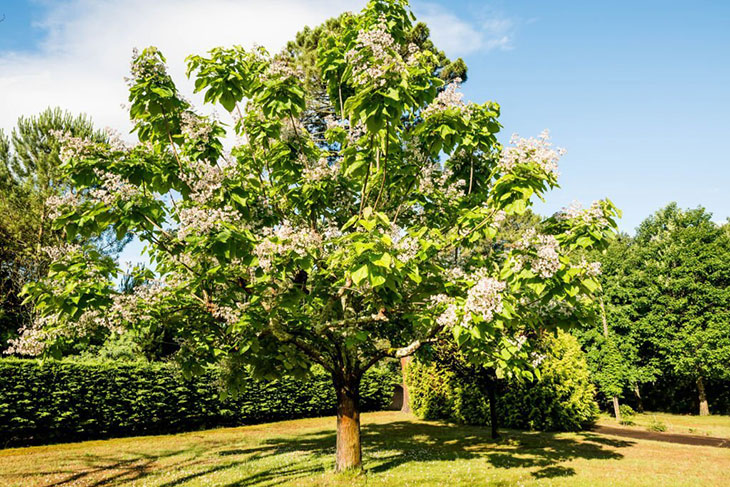
The Utah juniper, an evergreen tree native to southwestern North America, typically grows with a bushy appearance, featuring a rounded crown and multiple trunks.
Its roots compete well for moisture, and a mature tree usually stands under 30 feet. This juniper’s longevity can reach up to 650 years, and reproduces through seeds.
After two years, the Utah juniper’s small female cones develop into red or reddish-brown berries. The tree’s male cones are minute brown filaments near twig ends.
Its scale-like leaves, often paired oppositely, lend a coarse look.
The tree’s significance extends ecologically, covering around a fifth of Utah’s land. Its berries sustain wildlife, and its wood serves a wide range of purposes.
FAQs
What Are The Best Shade Trees For Northern Utah?
The best shade trees for Utah include the Quaking Aspen, famous for its vast range and status as the largest living organism. Its vibrant colors and unique growth make it captivating.
The Northern Catalpa is another shade tree with showy flowers, giant heart-shaped leaves, and twisting branches. Despite its distinct appearance, it’s a hardy choice, especially for parks and yards.
The Hackberry is known for its toughness, thriving in various conditions and providing energy-conserving shade.
What Are The Best Trees For Utah Yards?
Among the trees that grow fast in Utah, the Green Ash tree is notable. However, it’s prone to major insect damage, making it a risky choice due to the emerald ash and lilac borer.
On the other hand, the Autumn Blaze, Red or Freeman Maple trees are known for their rapid growth.
Still, they are weak-wooded and susceptible to iron chlorosis, which is exacerbated by Utah’s alkaline soil.
What Are The Trees That Grow Fast In Utah?
The trees that tend to grow faster in Utah include the maple, ash, and willow. Each species has its own specific requirements and considerations for growth and care.
- Maple trees, known for their vibrant foliage, have been observed to grow at a relatively rapid pace in Utah’s climate.
- Ash trees, with their graceful leaves and height, make them popular choices for shade and ornamentation.
- Willow trees, often found near water bodies due to their moisture-loving nature, can thrive quickly in suitable environments.
Conclusion
In Utah’s dry weather, it’s important to pick trees that can handle not getting much water. Trees like Rocky Lintain Juniper, Pinyon Pine, and Arizona Cypress are good examples.
They can survive with less water and still look nice.These drought tolerant trees Utah help make the place look better and also help the environment.
By choosing and planting these kinds of trees carefully, people can make spaces that save water, help animals, and make Utah a nicer place to live.
